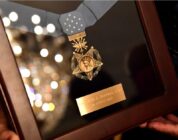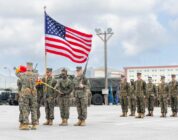For over two years, the men of Bravo Company, 2nd Battalion, 8th Infantry Regiment, 4th Infantry Division, engaged in near constant battle in the jungles of Vietnam’s Central Highlands. Since its deployment to Vietnam in early 1967, Bravo Company engaged in 94 separate firefights, enduring heavy combat in Pleiku and Kon Tum provinces, and participated in multiple campaigns including Operation Sam Houston, Operation Francis Marion and the 1968 Tet Offensive, according to an Army release.
Now, more than half a century later, 14 soldiers of Bravo Company were formally awarded Bronze Star Medals by U.S. Army Maj. Gen. John W. Weidner, chief of staff for U.S. Strategic Command, and Col. Robert Newbauer, commander of the U.S. Army Corps of Engineers, during a Sept. 18 ceremony in Omaha, Nebraska.
“These soldiers endured the worst of war,” Newbauer said during the ceremony, according to the release. “Their bravery and steadfast commitment to each other reflect the highest ideals of military service. It is an honor to stand with them as they receive long-overdue recognition.”
Nicknamed the Ivy Division for the pronunciation of the unit’s number in Roman numerals IV, the men of the 4th Infantry Division were tasked with disrupting enemy infiltration routes feeding the Ho Chi Minh Trail in the Central Highlands, which had quickly become a hotbed of enemy activity.
Lt. Gen. Stanley Larsen, former commander of I Field Forces responsible for the Highlands, had once cautioned, “If you ever let him get set, you’re going to pay hell getting him out.”
Larson had recommended “spoiling operations” to keep the North Vietnamese off balance — which the men of the 4th Infantry proceeded to carry out.
By 1969, the unit had received a Presidential Unit Citation and, in their own words, “decisively denied the enemy freedom of movement along the western highlands border.”
Yet the actions of these men went underrecognized for decades owing to the fact that award practices of the time saw junior enlisted soldiers receiving the Army Commendation Medal while officers — even those on the same mission — received a Bronze Star.
The medal itself was championed by Gen. George C. Marshall during World War II. In a memorandum to President Roosevelt dated Feb. 3, 1944, Marshall wrote:
“The fact that the ground troops, Infantry in particular, lead miserable lives of extreme discomfort and are the ones who must close in personal combat with the enemy, makes the maintenance of their morale of great importance. The award of the Air Medal have had an adverse reaction on the ground troops, particularly the Infantry Riflemen who are now suffering the heaviest losses, air or ground, in the Army, and enduring the greatest hardships.”
One day later, Roosevelt authorized the Bronze Star Medal by Executive Order 9419.
During the Sept. 18 ceremony, five veterans were awarded the Bronze Star Medal with Valor device for heroism in combat: 1st Lt. John E. Shaeffer, Sgt. Don J. Cantacessi, and Specialists Ronald Coleman, Roy F. Pline and Stephen Wittenberg.
“Each citation,” according to the release, “recalled moments when soldiers rushed into fire to aid comrades, provided critical leadership under pressure or exposed themselves to danger so others could survive.”
The nine other soldiers received Bronze Star Medals for meritorious service, upgrading earlier Army Commendation Medals. Among those recognized were: Spc. Arturo G. Cuellar, Spc. Charles P. Emery, Sgt. George A. Jones, Sgt. Dale G. Liefer, Sgt. Thomas P. Saumur, Spc. Marvin S. Weis, Spc. Ronald A. Wulff, and Spc. Clarence Kirshner, a combat medic.
These awards recognized the daily grind of combat leadership: squad leaders, riflemen and fire team leaders who, as Marshall put it, “lead miserable lives of extreme discomfort” to carry their men through some of the toughest fighting of the Vietnam War.




